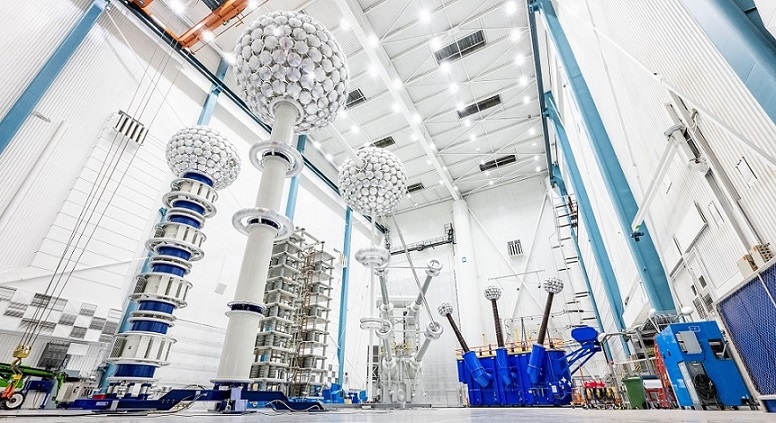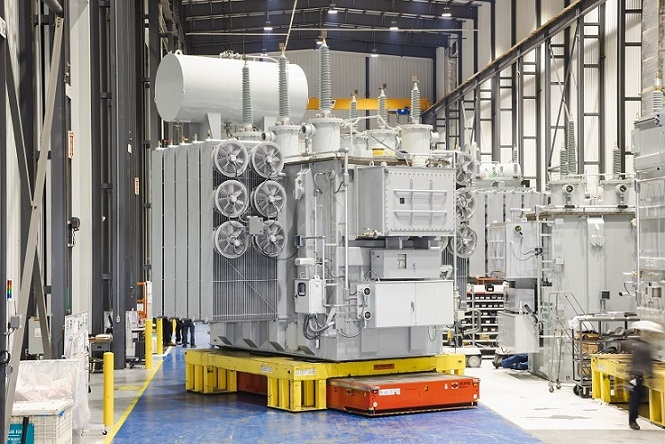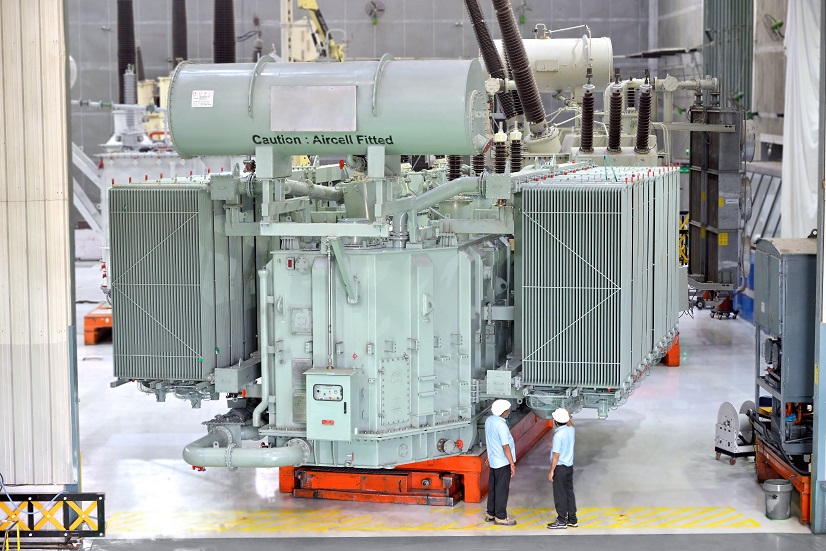As the world’s largest transformer manufacturer, Hitachi Energy remains dedicated to advancing a sustainable future through pioneering transformer technologies, asserts Bruno Melles, Managing Director, Transformers Business Unit, Hitachi Energy, in this exclusive interaction with T&D India. Considering the country’s growing energy requirements, Hitachi Energy envisions immense business potential in the transformer segment in India where the global conglomerate has an impressive array of seven manufacturing units producing power, dry distribution traction transformers, bushings and transformer insulation. An interview by Venugopal Pillai.

Power transmission involving HVDC technology is picking up rapidly worldwide, and also in India. How do you see Hitachi Energy gearing up to meet the global demand for HVDC-based equipment, especially transformers?
Electricity will be the backbone of our entire energy system. In the global power system of 2050, we will need around four times the power generation capacity and to transfer up to three times as much electrical energy, compared to 2020.
This is where HVDC excels because it stands out for its remarkable efficiency in transmitting substantial power over long distances and catering to specialized applications, contributing to the efficient integration of renewable energy but also being pivotal to enable grid reliability and resiliency. As a key enabler for a carbon-neutral energy system based on renewables, HVDC is shaping the grid of the future.
Hitachi Energy has been the pioneering leader in the HVDC market since the 1950s, continuously evolving this technology to meet the demands of a dynamic energy ecosystem. We have delivered more than half of the world’s HVDC projects and designed and manufactured more than 550 HVDC converter transformer units in the 80 kV, -1,100 kV DC voltage range.
Striving for continuous innovation in sustainable energy solutions, Hitachi Energy has developed Ultra-High-Voltage (UHV) technology as an advancement of HVDC, designed to transmit massive power with minimal losses and integrate renewables. We have successfully developed and tested 1,100 kV converter transformer technology, breaking the record for the highest DC voltage levels ever.
Similarly, our DC transformers bushings are designed to provide reliable and efficient electrical insulation and connection for high-voltage DC transmission and distribution systems.
As an example, Hitachi Energy in India concluded two large UHVDC projects in the last decade and gained significant experience to leverage the enhancements in HVDC technology on the way.
Our company has integrated over 150 GW of HVDC links worldwide demonstrating our ability to handle large-scale projects. We are also in the process of expanding our global footprint and investing systematically to align the demand for HVDC converter transformers in India and globally.

India will soon be embarking on building large-scale offshore wind energy farms. How do you see the business opportunities in the offshore market for Hitachi Energy with respect to HVDC equipment?
Since the first commercial projects in the early 1990s, offshore wind electricity generation has grown enormously. Today, it is a fast-growing, promising means of delivering consistent, clean, and affordable electricity. Transformers are a key requirement for the transmission of electricity generated in offshore wind farms.
HVDC technology is also used to integrate power from offshore wind generation, which opens business opportunities for HVDC equipment worldwide.
At Hitachi Energy, we have a complete and qualified range of equipment for offshore wind applications. With OceaniQTM we have a comprehensive and qualified portfolio designed for various offshore environments, such as fixed-bottom, floating, and subsea applications that is an example of our commitment to supporting the offshore wind industry with reliable and innovative solutions.
“Our company has integrated over 150 GW of HVDC links worldwide demonstrating our ability to handle large-scale projects.”
Hitachi Energy is the world’s largest transformer manufacturer in terms of installed base. What’s your vision for the Hitachi Energy Transformer business?
We remain dedicated to advancing a sustainable future for all through our pioneering transformer technologies and addressing the complex challenges that arise in this field.
The demand for transformers and electrical equipment is growing at a fast pace, and we are investing to expand our global footprint and address our customers’ mid- and long-term needs. In April 2024, we announced investments of over $1.5 billion to ramp our global transformer manufacturing capacity to keep pace with the growing power demand.
Through these investments, Hitachi Energy focuses on expanding its global transformer capacity by 2027, covering our operations in Europe, the Americas, and Asia to meet the growing demand for power and distribution transformers. Our global investments reiterate our commitment to co-create the path to accelerate the energy transition with our utility and industry customers and partners, meeting the demand from growing market segments like renewables and data centers, this one especially facing a great boost in investments due to the power implications of Artificial Intelligence.
Today, we are the world’s largest transformer manufacturer in terms of installed base, portfolio range, manufacturing capacity, and market coverage. We have over 60 transformer factories and 30 service centers worldwide. The capacity and footprint expansions will increase the speed to market to meet this accelerating global demand, address long-term customer investments, and create over 4,000 jobs.
“In April 2024, we announced investments of over $1.5 billion to ramp our global transformer manufacturing capacity to keep pace with the growing power demand.”
On a technical note, Hitachi Energy, we learn, is rapidly moving towards replacing OIP bushings with RIP bushings not just in its own transformers but is also emerging as a RIP bushings supplier to other transformer manufacturers. Please discuss.
Hitachi Energy has invested in the local Resin Impregnated Paper (RIP) Bushing plant in India in 2022, achieving remarkable results in a very short period. In about two years, we’ve supplied more than 600 bushings, including those to external transformer manufacturers.
We are committed to the highest standards of sustainability, striving to achieve carbon neutrality not just within our operations, but also by assisting our customers and supporting the nations’ growth initiatives. Our award-winning factories support local production and contribute to sustainable operations.
We are further investing to scale up the production of our dry bushings portfolio RIP and RIS (Resin Impregnated Synthetic) bushings to support the market growth in some countries like India, which is changing rapidly from OIP (Oil Impregnated Paper) to RIP/RIS bushings that provide enhanced safety and sustainability performances.
We are continuously investing in continue enhancing our bushing technologies. For instance, the EasyDry® transformer bushings are part of our flagship RIS solutions, which substitutes traditional paper insulation with synthetic material, AiRIPFlex is our modular design concept for high-voltage RIP transformer bushings, and GOB+ is our latest innovative addition to our bushings portfolio, building on the legacy of oil-impregnated transformer bushings.
These advancements and investments demonstrate Hitachi Energy’s commitment to meeting the evolving needs of the market and supporting the global transition to more advanced and sustainable bushing technologies.

Over the recent past, we see significant investment made by Hitachi Energy in its global operations. Please discuss Hitachi Energy’s plans for enhancing its facilities in India and other parts of the world with respect to the transformer business.
Hitachi Energy is leveraging its global footprint to support the global demand of transformers, driven by the continued efforts to further electrify the energy system.
Factories like the ones in India and other parts of the world, backed by the expertise and commitment of its teams, are supporting customers all across the globe with power, distribution transformers, shunt reactors, components, and services.
As a market leader, we have revolutionized transformer technology and pioneered many world firsts to bring safety, reliability, and efficiency to power distribution networks around the globe. India remains a significant part of the growth story. Here we are leading the process of establishing high level of competency and infrastructure while leveraging the high-end talent pool available to serve the new requirements from larger and more complex grid with renewables power and long-distance transmission system.
We have vibrant multi-skill technology competence centers in Chennai, Bangalore and Vadodara that are catering to India as well global project deliveries and have already demonstrated capability through several successful pursuits and deployment of most modern and technically advanced technology solutions.
Today, Transformers is the largest business unit at Hitachi Energy in India, with a wide product portfolio ranging from power transformers to dry transformers, dedicated to domestic and export sales. We count on seven transformer manufacturing units producing power, dry distribution traction transformers, bushings and transformer insulation, and we plan to keep investing and grow our teams to enhance their capabilities, capacity and operational efficiency.
Considering India’s growing energy requirements, we envision immense business potential in the transformer segment. We are constantly evaluating growth opportunities to strengthen and scale up our manufacturing capacity and capabilities, in line with the global expansion plans announced earlier this year.
“The use of natural and synthetic ester oil for power transformers is evolving fast and Hitachi Energy is leading the technology developments to make use of these special fluids.”
Hitachi Energy is making significant contribution to Indian Railways by way of high-rating Scott-connected transformers. How do you see the road ahead for Hitachi Energy’s Scott-connected transformers worldwide?
The push for faster and more frequent train services, in response to rapid urbanization and the increasing demand for mobility, requires an efficient and reliable rail transportation system. Scott-connected transformers emerge as the ideal solution to meet these power requirements to increase axle load, train frequency, and the power rating of locomotives or train sets, as they help balance catenary loads.
Hitachi Energy is the first company to supply India’s highest power-rated Scott transformers, with several units of 100MVA conforming to the specifications of the Research Design and Standards Organization (RDSO) for Indian Railways. These Scott transformers will revolutionize the rail infrastructure’s electrical system in India, enabling trains to accelerate to 160 kmph.
This is a significant improvement, marking a 20 per cent increase over the current maximum speed of 130kmph. This solution developed for the Indian rail network sets a benchmark for the rest of the world in terms of high-power railway applications. So, we see immense potential for Scott-connected transformers in the immediate and remote future.

As a step towards sustainability, transformer manufacturers are moving towards replacing conventional mineral oil with natural or synthetic ester oil. What is the situation with respect to Hitachi Energy?
For distribution transformers, Hitachi energy has proven records with retro fill, as well as new transformers, and has a large installed base.
The use of natural and synthetic ester oil for power transformers is evolving fast and Hitachi Energy is leading the technology developments to make use of these special fluids.
Hitachi Energy has developed solutions for high voltage levels and many pursuits are on the way to enhance these solutions to include EHV/UHV voltage applications relevant for a more sustainable and efficient power grid.
“At Hitachi Energy, the first fundamental step in sustainability is ensuring all our factories are carbon-neutral.”
In a very broad sense, how do you see Hitachi Energy’s transformer business contributing to cost-effective, efficient and greener power grids, globally?
At Hitachi Energy, the first fundamental step in sustainability is ensuring all our factories are carbon-neutral. Therefore, we aim to power our processes with renewable energy sources across all our facilities. All the announced transformer investments to expand our global footprint include sustainable and innovative manufacturing technologies for operational efficiency while ensuring high standards for safety and quality. It also aids the company’s efforts to become carbon-neutral by 2030 and aims to create positive economic and social impact in the local communities.
The second step is how we design and the type of design we use in our products. On cost effectiveness, we promote the concept of total cost of ownership for customers, to make economically sound informed decisions considering the transformer life-cycle costs.
On energy efficiency we have solutions to further enhance efficiency of transformers beyond existing market standards today and with the rest of the Hitachi Energy portfolio we contribute to improving efficiency at system level, as we did with the Scott-connected transformers for Indian Railways. We are enhancing the sustainability of power grids on two levels:
- Enabling the energy transition with solutions to connect more renewables and reduce losses in energy transmission (HVDC units)
- Using a scientific, data-driven approach to calculate the environmental life cycle impacts at the transformer level and following eco-design principles in improving these impacts.
At Hitachi Energy, we are committed to advancing cost-effective, efficient, and sustainable power grids on a global scale. Our journey is driven by a passion for innovation and sustainability, together with our customers and partners, we strive to create solutions that not only meet the energy demands of today but also pave the way for a greener and more sustainable future.


